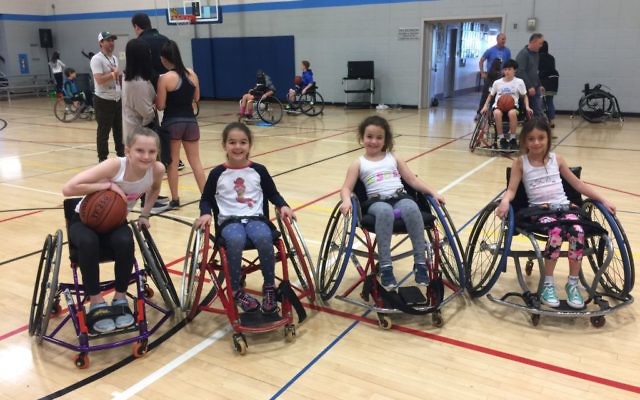Fair Competition Helps Disabled Get Rolling
More than 300 crowded into the Marcus JCC auditorium Feb. 26, celebrating Israel Sports Center for the Disabled
More than 300 people crowded into the Marcus Jewish Community Center auditorium Sunday, Feb. 26, to celebrate the Israel Sports Center for the Disabled, which helps children push past disabilities to become adults fully integrated into society.
The event, which was free to attend, was organized by the American Friends of the Israel Sports Center for the Disabled, which raises money and awareness for the center. Donations associated with the event, matched by the Michael & Andrea Leven Foundation and an anonymous donor, brought in more than $100,000 for the center.
“The one thing that’s changed my life … is sports,” said Boaz Kramer, the executive director of the Sports Center for the Disabled and a paraplegic who plays tennis.
Sports are based on competition and giving each side a fair chance to win. Everyone plays by the same rules.
That level playing field means a lot to those who face longer odds in life because of disabilities. Sports give them a fair environment and a fair chance to win.
While those with disabilities may have an equal shot at winning a science fair, they don’t get to play on the high school football team. They can’t join the track team or have a go at basketball. It wouldn’t be fair to them or to the teams.
The Israel Sports Center for the Disabled gives athletes that opportunity to compete.
Caroline Tabib, who placed fifth in the Rio Paralympics in table tennis, said her passion for sports started with swimming at the center. She wanted so badly to win and almost began to cry just thinking about that her first match.
Swimming is incredibly important at the center, Kramer said. It helps youngsters learn to trust their bodies as they learn to float, and it increases strength. From swimming, people move into different sports.
Tabib went into table tennis, which took her to the Paralympic Games. But the Sports Center for the Disabled’s goal is not to make Olympians, Kramer said, but to give everyone a chance to win and to improve their bodies.
When the presentation moved from the Dunwoody center’s auditorium to the basketball court, attendees learned how similar wheelchair basketball is to regular basketball. The court, scoring and number of players are the same. The basketballs are the same, and the hoops are the same height.
If players fall, they simply push themselves back up, which players demonstrated by placing their hands out and doing push-ups. Getting back up took less than two seconds.
Instead of the consistent dribble required of able-bodied players, wheelchair players push their chairs twice and dribble once. Each wheelchair is built for the specific player, depending on his or her disability. The players must be strong and have full control of their chairs.
Able-bodied attendees got to try wheelchair basketball themselves after watching the demonstration.
“Any time that I can share my sport, I’m excited,” said Gavin Cloy, who plays wheelchair basketball with the Shepherd Center and participated in the demonstration.
Awareness is a large part of helping such organizations, and being more knowledgeable helps able-bodied people decide when people with disabilities need someone to intervene on their behalf and when they don’t need help, as when wheelchair basketball players fall.
“The wheelchair basketball event was an enormous success on multiple levels,” said Isaac Frank, who organized the event with his wife, Vanessa, and with Florie and Danny Glusman and Michelle and Rob Leven. “Not only did we raise much-needed funds for the Israel Sports Center for the Disabled, but more importantly we helped educate our community on the challenges facing those living with physical and mental disabilities.”





comments